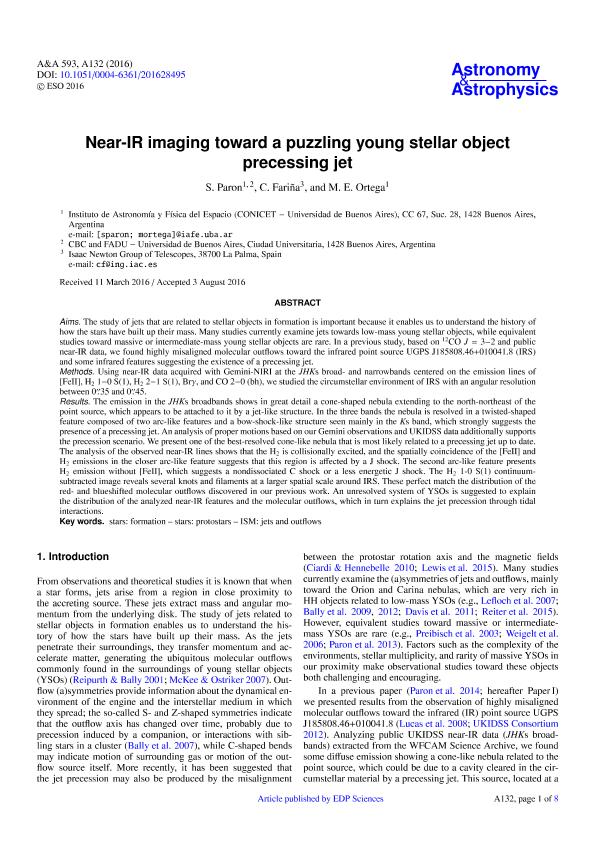Artículo
Near-IR imaging towards a puzzling young stellar object precessing jet
Fecha de publicación:
08/2016
Editorial:
EDP Sciences
Revista:
Astronomy and Astrophysics
ISSN:
0004-6361
Idioma:
Inglés
Tipo de recurso:
Artículo publicado
Clasificación temática:
Resumen
Aims. The study of jets that are related to stellar objects in formation is important because it enables us to understand the history of how the stars have built up their mass. Many studies currently examine jets towards low-mass young stellar objects, while equivalent studies toward massive or intermediate-mass young stellar objects are rare. In a previous study, based on 12CO J = 3−2 and public near-IR data, we found highly misaligned molecular outflows toward the infrared point source UGPS J185808.46+010041.8 (IRS) and some infrared features suggesting the existence of a precessing jet. Methods. Using near-IR data acquired with Gemini-NIRI at the JHKs broad- and narrowbands centered on the emission lines of [FeII], H2 1−0 S(1), H2 2−1 S(1), Brγ, and CO 2−0 (bh), we studied the circumstellar environment of IRS with an angular resolution between 000 .35 and 000 .45. Results. The emission in the JHKs broadbands shows in great detail a cone-shaped nebula extending to the north-northeast of the point source, which appears to be attached to it by a jet-like structure. In the three bands the nebula is resolved in a twisted-shaped feature composed of two arc-like features and a bow-shock-like structure seen mainly in the Ks band, which strongly suggests the presence of a precessing jet. An analysis of proper motions based on our Gemini observations and UKIDSS data additionally supports the precession scenario. We present one of the best-resolved cone-like nebula that is most likely related to a precessing jet up to date. The analysis of the observed near-IR lines shows that the H2 is collisionally excited, and the spatially coincidence of the [FeII] and H2 emissions in the closer arc-like feature suggests that this region is affected by a J shock. The second arc-like feature presents
H2 emission without [FeII], which suggests a nondissociated C shock or a less energetic J shock. The H2 1-0 S(1) continuumsubtracted image reveals several knots and filaments at a larger spatial scale around IRS. These perfect match the distribution of the red- and blueshifted molecular outflows discovered in our previous work. An unresolved system of YSOs is suggested to explain the distribution of the analyzed near-IR features and the molecular outflows, which in turn explains the jet precession through tidal interactions
Palabras clave:
Stars: Formation
,
Stars: Protostars
,
Ism: Jets And Outflows
Archivos asociados
Licencia
Identificadores
Colecciones
Articulos(IAFE)
Articulos de INST.DE ASTRONOMIA Y FISICA DEL ESPACIO(I)
Articulos de INST.DE ASTRONOMIA Y FISICA DEL ESPACIO(I)
Citación
Paron, Sergio Ariel; Fariña, C.; Ortega, Martin Eduardo; Near-IR imaging towards a puzzling young stellar object precessing jet; EDP Sciences; Astronomy and Astrophysics; 593; A132; 8-2016; 1-8
Compartir
Altmétricas




